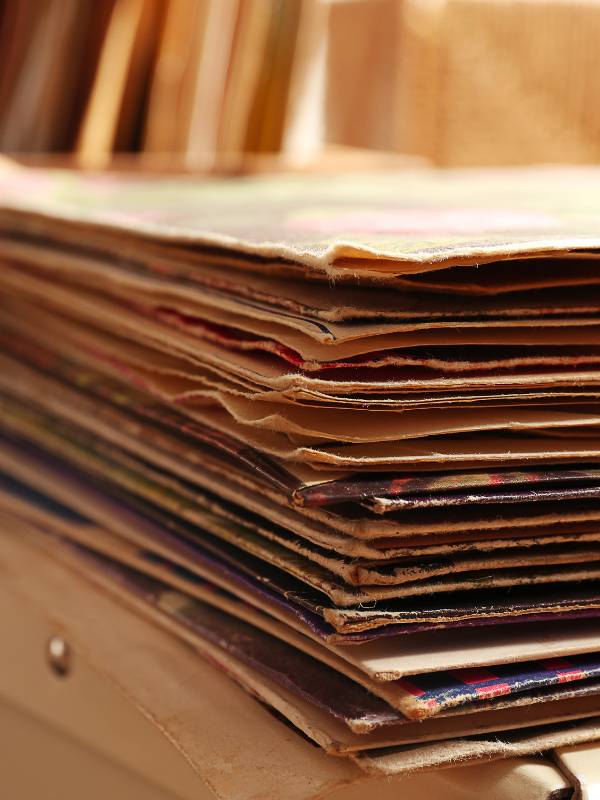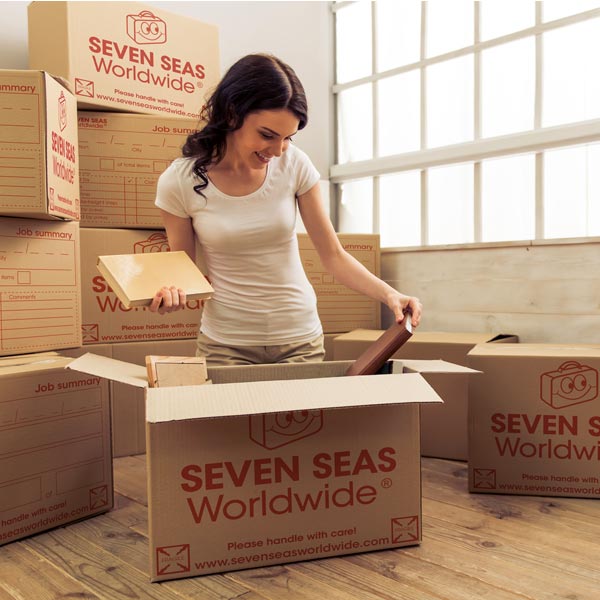Before packing, check this list of items prohibited from entering a particular country or region.
Why is it important to pack fragile items carefully?
During international transit, your belongings will pass through numerous stages, including handling at various ports, loading and unloading onto different modes of transportation, and potentially long periods at sea. Although our international shipping company prides itself on treating your shipment with the utmost care, fragile goods are susceptible to damage from vibrations, impacts, and pressure changes. Therefore, we highly recommend obtaining a quote from a domestic removal company that offers professional packing services. Otherwise, carefully follow our tips below to ensure everything arrives at its destination intact.

Best packing material for fragile items
Choosing the correct packing materials is crucial to protect fragile items during long shipping journeys. Whether moving delicate glassware, cherished artwork or your favourite tea set, suitable materials help ensure a stress-free experience.
Here are our top packing material picks designed to safeguard your valuables:
Bubble wrap: the king of packing material's cushioning properties protect delicate objects from shocks and impacts during transit. To maximise protection, ensure the cushioned (bubbly) side is against the item, and wrap generously.
Packing paper: this material is cost-effective, recyclable, and ideal for wrapping glassware and kitchenware or filling empty spaces within boxes to prevent movement when crumpled.
Strong cardboard boxes: sturdy cardboard boxes are indispensable for packing heavy or fragile items. Their durability helps ensure your possessions remain protected and clean during long overseas shipping journeys and storage.
Foam or cardboard edge protectors: designed to protect fragile items' corners and edges from damage. They are particularly effective for mirrors, picture frames, and electronics.
Tissue paper: ideal for wrapping very delicate items, such as fine china or collectables, as it provides a direct buffer to prevent scratches.
Crumpled paper: easily found at home, materials such as unused gift wrapping paper or magazines can be crumpled up and used to fill gaps in boxes — an inexpensive but effective way to prevent items from shifting.

Fragile items examples
A fragile item is any easily breakable object that is susceptible to damage. It is typically made from materials like glass, porcelain, softwood, ceramics, or thin/sensitive electronic components.
Common examples of fragile items include:
- Wine glasses,
- Kitchenware,
- Porcelain figurines,
- TV and PC screens,
- Mirrors.
Below is a handy infographic showing a simple six-step process for avoiding breakages.

Where do you put a fragile sticker on a package?
Put fragile stickers on multiple sides of your package to ensure visibility from all angles. Apply one on the top, front and back, and near the shipping label to maximise visibility and encourage careful handling by removers, port staff, and friends and family. Doing so ensures your fragile goods are treated with the utmost care throughout their shipping journey.
![]()
How to pack wine glasses
Due to their delicate stems and thin glass, packing wine glasses requires great care. Begin by thoroughly cleaning and drying each glass to avoid moisture damage or stains during shipping. Then, closely inspect them for any pre-existing cracks or chips.
Next, wrap the entire glass in several layers of bubble wrap*, with extra layers around the stem until it's as wide as the wrapped bowl, then seal with tape. Stuff crumpled packing paper inside the bowl until it's full. For extra protection, wrap the glass in a small layer of spare cardboard and a final layer of bubble wrap, sealing both with more tape.
When putting your wrapped glass into sturdy, double-walled boxes, ensure they are standing vertically and placed as centrally as possible. Insert cardboard dividers between each to prevent them from touching, and fill any remaining space with packing paper or towels to restrict movement during transit.
For ultimate protection, consider double-boxing: place a smaller box containing only your wrapped wine glass into a larger one with at least three inches of cushioning materials between them.
Top tip: when you arrive at your destination, unpack your wine glasses immediately to reduce the chance of damage from prolonged pressure.
For ultimate protection, consider double-boxing...

![]()
How to pack picture frames
Start by placing low residue tape* over the glass in an "X" shape to reduce vibrations and prevent cracking or breaking. Plus, it stops the glass from shattering into small pieces if it does get knocked, making unwrapping at the end safer.
Cover each frame in tissue or packing paper and seal with brown parcel tape. Then, wrap the frame in several layers of bubble wrap and seal with more tape. Pay close attention to the corners of your frame, which are prone to damage. Consider buying cardboard corner protectors* for extra peace of mind.
Next, wrap your frame with cushioning materials, such as kitchen towels or, for bigger frames, moving blankets. Choose a sturdy, appropriately sized box and consider a specialised box for shipping picture frames*. Such boxes often have a telescoping feature, which means they can be adjusted to fit the frame and allow the packing of two frames together, separated by cardboard.
Layer the bottom of the box with packing paper for additional protection, and fill gaps with more material to prevent movement during transit.
Top tip: using a marker pen, write "glass side" on the picture side of each frame to inform anyone handling it to take extra care.
![]()
Best way to pack plates for moving
Start by making sufficient space on a table and gathering all your packing materials, such as scissors, packing paper, bubble wrap, a knife, and packing tape. Prepare the plates by cleaning and drying them thoroughly to avoid moisture, dirt, or dust build-up during transit.
Lay several sheets of packing paper on the table and place your first plate in the centre. Fold two or three sheets over the plate, starting from one corner. Place a second plate on top and fold the paper from another corner over it. Repeat this process with a third and fourth plate. Finally, wrap any remaining paper around the entire stack and secure it with packing tape.
Alternatively, place one or more layers of bubble wrap between each plate and stack them three or four high. Secure the stack with two extra layers of bubble wrap, then seal it with parcel tape.
Next, take a sturdy cardboard moving box and line the bottom with a two-inch layer of crumpled paper for cushioning. Add cardboard dividers between stacks for an extra layer of protection, and fill spaces with towels or packing paper to prevent movement during transit.
Top tip: once wrapped, place your plates vertically into the box, away from the sides.
![]()
How to pack monitors
Start by disconnecting all cables, placing the monitor in a protective bag, and covering it with bubble wrap. Remove any attachments, such as a monitor stand or webcam. Clean the screen with a specialised cleaning solution* to prevent dust and moisture from gathering during transit. Then, cover the screen with a microfibre cloth or anti-static wrap secured with parcel tape.
If you still have it, use the original box your monitor came in. These boxes are usually made from sturdy cardboard and include polystyrene packaging perfectly curved to your screen's shape. You can also store your cables and attachments in them.
Otherwise, choose an appropriately sized box made from double-walled cardboard and line the bottom with foam or crumpled paper for cushioning. Then, wrap the monitor in several layers of bubble wrap, secured with parcel tape. Consider adding a section of cardboard to cover the screen for added protection. Place the monitor upright inside the box, ensuring it fits snugly.
Top tip: avoid cleaning screens with paper towels, tissues, or household cleaning products, as these can scratch.
![]()
How to wrap a mirrors
Gather all necessary packing supplies, including an appropriately sized box, packing tape, cardboard sheets, bubble wrap, blank labels, packing paper and corner protectors.
Thoroughly clean and dry the mirror to avoid any buildup of dirt and dust. Then, lay it flat on a sturdy surface and place a large "X" across the surface with low residue tape to prevent the glass from shattering if it breaks.
Next, wrap the entire mirror in packing paper to protect it from scratches, followed by multiple layers of bubble wrap for cushioning. Secure the bubble wrap with packing tape, making sure it is tight.
Place the mirror between two pieces of cardboard cut to the size of the mirror to form a protective shield. Tape them securely. Then, carefully slide it into a double-walled cardboard mirror box*. If there's space inside the box, fill it with crumpled packing paper or other padding materials to prevent the mirror from shifting during transit.
Top tip: if your mirror has sharp corners, add corner protectors.
*Seven Seas Worldwide does not endorse these products.
Packing paper vs bubble wrap
Packing paper and bubble wrap serve different purposes when packing fragile items. Packing paper is ideal for wrapping to prevent surface scratches and, when crumpled, serves as filler to stop movement during shipping.
Bubble wrap, on the other hand, offers outstanding cushioning against impacts for most items. It's ideal for delicate goods like glassware, china or electronics. While both materials are essential, bubble wrap is preferred for its protective qualities and versatility. However, remember that the bubble side of the bubble wrap should face toward the item to ensure effective cushioning from impacts. Conversely, the smooth side should face outward, making it easier to secure it with tape.
How to pack vinyl records for moving
To pack vinyl records for moving, start by thoroughly cleaning and drying each record to prevent damage caused by friction from dirt or grime during transit. While a specialised vinyl cloth may suffice, consider buying a professional vinyl record cleaning machine* for a more thorough job.
Pack and label each box in the same order you display your records at home. The following are some common ways people like to display their vinyl collections:
- Alphabetically: by artist or album name.
- By genre: the style of music, e.g., rock, indie, grunge, pop, jazz, classical, etc.
- Chronologically: by release date to show music's progression over time.
- By record label: ideal for fans or collectors who favour specific labels' output.
- Decade or era: by the years they were released (e.g., 60s, 70s, 80s), reflecting the music's evolution.
Use a sturdy vinyl storage box slightly bigger than the records* to avoid movement during transit. When packing, position the box on its side to allow the weight of the records to compress, reducing gaps. Once complete, the vinyls will stand vertically. However, be careful not to exceed the maximum container weight set by your movers or shipping company. For example, at Seven Seas Worldwide, the maximum weight per box, bag, or suitcase is 30kg/66 lbs.
Alternatively, wrap groups of 5 to 10 records at a time in bubble wrap or packing paper and stack them like books. Consider purchasing outer sleeves made from high-density polypropylene* for added protection, perhaps only for exceptionally sentimental or expensive LPs.
Fill empty spaces in the box with crumpled packing paper to keep everything secure. Ideally, your box should feel snug without being overpacked, as this can cause pressure and lead to damage. Seal the box with several overlapping layers of parcel tape and mark it as 'fragile'. Adding 'this way up' and 'keep cool' labels can also help ensure careful handling.
*Seven Seas Worldwide does not endorse these products.
Fill empty spaces in the box with crumpled packing paper to keep everything secure. Ideally, your box should feel snug without being overpacked...

Fragile items need ample cushioning on all sides to absorb shocks during transit.

Packing fragile items: common mistakes
Packing fragile items for shipping can be tricky, and mistakes can increase the risk of damage. Therefore, proper planning and attention to detail are essential to ensure your valuables arrive safely at their destination.
Here are our top packing mistakes to avoid for fragile items:
Using an incorrect box size: oversized boxes can allow too much movement during transit, while undersized boxes can create tightly packed items, creating excessive pressure.
Not adding enough padding: fragile items need ample cushioning on all sides to absorb shocks during transit. If in doubt, always opt to over-pad.
Failing to label boxes correctly: labels like "Fragile", "Handle with Care", and "This Side Up" ensure careful handling during transit.
Ignoring weight distribution: packing heavy items on top of lighter, fragile ones can lead to crushing. Ensure heavier items are placed at the bottom and lighter things above and away from your box's sides.
Overpacking your boxes: items may collapse under too much pressure, and boxes could burst open during transit.
Packing items too close together: objects can collide during transit without proper separation, leading to damage. Use dividers or separate them with bubble wrap.
Forgetting to reinforce box seams: weak seams often split, exposing the box's contents to damage. Sufficiently cover them with multiple layers of parcel tape.
Using the wrong packing materials: avoid using newspaper for delicate items, as it can transfer ink and stain.
Neglecting to protect corners: items with sharp corners, such as mirrors or picture frames, require corner protectors for extra padding.
Using weak boxes: avoid used boxes, storage boxes or boxes that once contained organic material e.g. fruit crates and Hello Fresh boxes.











